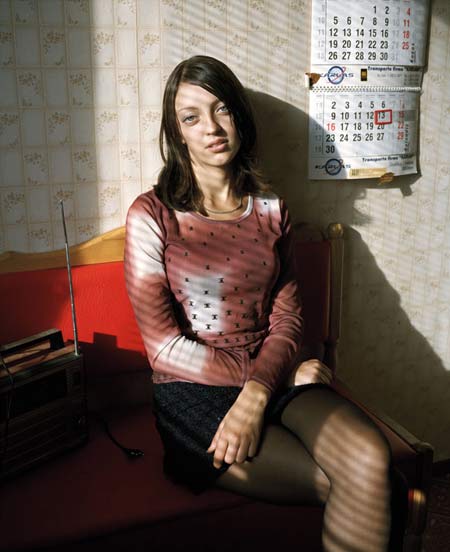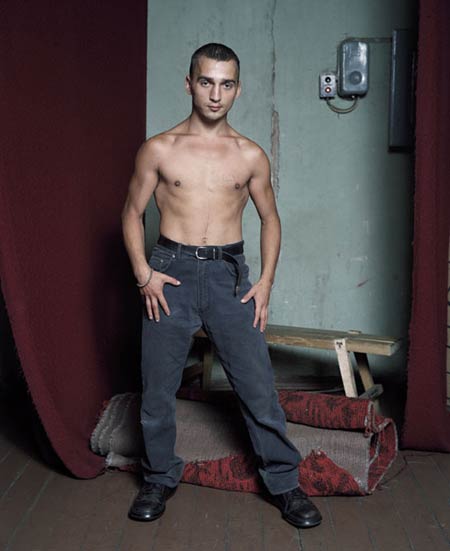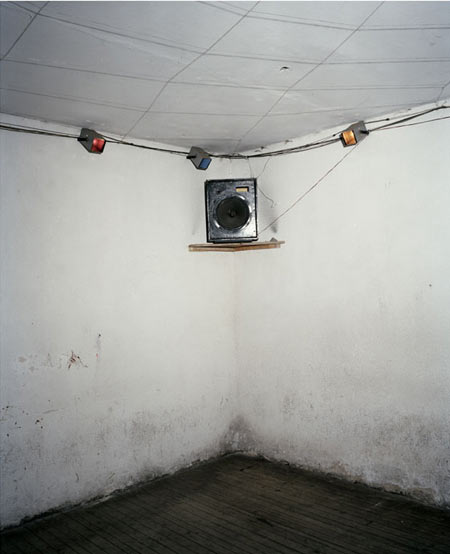A Conversation with Andrew Miksys

When I first saw Andrew Miksys’ Baxt I realized I was dealing with something a bit different. Let’s face it: Most people only know the Roma (“gypsies”) as a comedic backdrop from the movie Borat, and there still exist considerable stereotypes (and worse) about them. So I asked Andrew whether he would be up for a conversation about his work.
Jörg Colberg: You spend a considerable amount of time in Lithuania, a country which also features quite prominently in your work. I’d be curious to learn why.
Andrew Miksys: My father was born in Lithuania. He was very young when he fled Lithuania in 1944 with my grandparents to escape the Soviet invasion. They were middle class Lithuanians and feared being deported to Siberia. After a 50-year absence my father returned to Lithuania in 1995 to visit our relatives. I really didn’t know that much about Lithuania and I went along reluctantly. Right away, though, I realized that it would be an interesting place to photograph. Lithuania was still a bit frozen in time. A lot of the villages hadn’t changed much in hundreds of years, and there were remnants of the Soviet Union everywhere. Since my first visit Lithuania has moved with stunning speed from a former Soviet republic to a thriving EU member and I’ve found a lot of material to photograph.

JC: How did you decide about doing a project about the Roma in Lithuania? And how did you then pursue the subject? How did you approach the Roma?
AM: In 1998 I received a Fulbright grant to photograph in Lithuania for one year. My method of photographing was to simply wander around and see what I could find. About half way through my stay I came across a Roma family in Vilnius. I had no idea there were Roma in Lithuania and was surprised to find them here. I started to do more research and discovered that there were small groups of Roma in Vilnius and in many villages throughout Lithuania. At first it was very difficult to gain their trust. The Lithuanian press has done a great job demonizing the Roma and they’re very reluctant to speak to journalists and photographers. Over time, though, I was able to make contacts and photograph. Once I got to know Romani people I realized very quickly that they are warm and generous people. My mother’s side of the family is Italian and the Roma often remind me of my Italian relatives - very loyal to family, always wanting to feed you, talk to you, etc. I think it also helped that I gave people copies of the photographs I took of them. In almost any Roma home you’ll find family photos everywhere and I think they appreciated this gesture. Now I’m often asked to photograph weddings and funerals in the Romani community.
JC: The Romani’s history contains many episodes of persecution, and as far as I can tell, they never managed to completely escape from it. Given the outright hostility in many parts of Europe towards them, did you encounter any problems with people in Lithuania when you spent time with the Romany? And do you think your work will help people to change their ideas of who the Romany are - especially given most people really only know them as “gypsies”, most recently featured as the stereotypical subjects of hatred in the Borat movie?
AM: Interesting you should ask about Borat. I was in Seattle recently for a book release event with Andrei Codrescu (Andrei wrote the introduction to my book). Someone from the audience asked Andrei what he thought of Sacha Baron Cohen ripping off his film Road Scholar. In 1996 Andrei drove from New York to San Francisco in a red Cadillac convertible seeking to uncover some of the oddities and ironies of American culture. On the surface, the parallels with Cohen’s film are fairly obvious: Andrei is originally from Eastern Europe (Romania) and shows America through the eyes of a foreigner with plenty of humor. Like Cohen, Andrei is also Jewish. However, Andrei was able to poke fun at people without being cruel.
It’s a little surprising that Cohen is not more aware of the struggles of the Roma. The Roma and Jews were both considered “racially inferior” by the Nazis and were systematically murdered during WWII. I thought Borat did a very good job confronting anti-Semitism. This remains a problem in Eastern and Western Europe. Unfortunately, he didn’t treat Antiziganism (anti-Gypsyism) with the same sensitivity.
As it is, the Roma still have no voice and few advocates. Portrayals of them usually fit well-defined stereotypes of an immoral people who lead very chaotic lives and that have values that run counter to those of the majority. There is no doubt that the Roma are facing very serious poverty and all over Eastern Europe they’ve been unable (and often unwilling) to integrate with local populations. These issues often set them apart. However, the media tends to rely on sources of information about the Roma that are from the “outside” and people who haven’t spent much time with the Roma. In truth, the Roma are VERY traditional people and the real issue is a clash of cultures between their traditional culture and the modern world.
It’s not just Borat. About a year ago the New Yorker had a review of a book about the Roma and ran a grainy black and white photograph with all the usual clichés, a woman holding a baby, barefoot children and wild dogs. This is just the surface. If you go inside a Romani house, even the most dilapidated shack of a house, you’d find bedrooms and a living rooms that are immaculate and in perfect order. There is an image in Baxt of a girl wearing a “PUNK” t-shirt and pink slippers. Everything in her room is neat and tidy. Her house, though, is a little wooden shack in a region of Vilnius with no paved roads and railroad tracks running through it. I could have photographed her outside with a bunch of other kids trying to jump into the frame. But that sort of image would have just been for show, for my camera, and would have failed to capture the more intimate reality of the Roma that interests me.
In general I think it’s always difficult to gauge what effect my work has on people or what they might see or how they might interpret my photographs. I’m a little wary of photography that claims to address social or environmental injustices and even find it a bit cynical when artists attach their work to a social cause. I think photographs need to stand on their own regardless of their political/social agenda. Being politically correct is not enough. I think the photographer’s political agenda should be an integral part of a photograph rather than something addressed in an artist statement.
Having said all this, I do think my photographs have helped produce a more positive view of the Roma in Lithuania. Many people here still rely on stereotypes to form their views of the Roma. Like I said already, this is simply due to the fact that most have little or no contact with the Roma. My portraits, though, are up close and personal. Viewers are placed in the living rooms and bedrooms of Romani people. I think they are surprised by this intimacy and the very “real” people they find in my photographs. This might not be directly political, but I think it has a positive impact.

JC: I noticed that most of you projects appear to be split between portraits and very stark still lives or scenes that often only barely show human traces. What is the idea behind that?
AM: Portrait photography has always been my main interest and all my projects begin by taking portraits. However, the still lifes, exteriors, and interiors that follow are just as important. In these pictures I’m trying to make images that have a similar emotional and visual quality as the portraits. There might not be any people in these pictures, but you can find the remnants or “debris” of human activity. And when I’m working on a large body of work these pictures are helpful in telling a story or creating a narrative. This was very important when I was sequencing the photographs for my book. Of course, it’s possible to do a book with only portraits, but I felt some of these other images gave the themes in my book more room to breath and provided some context for the portraits.
JC: How do you go about finding images that can go along with the portraits? Do you find these spontaneously, or do you plan this a little bit?
AM: Most of the time I set out to take portraits. But often there is a break in the action or simply no opportunity to take portraits and I start looking around for other things to photograph. I wouldn’t really put one before the other, though. It’s just the way I work. Everything flows together.

JC: What is your approach to taking portraits? Do you guide your subjects, or do you let them pose themselves?
AM: My approach to taking portraits definitely changed while working on the Roma and Disco projects. One of my early Roma photographs is of the girl standing against the wall with the big photo mural wallpaper behind her (page 21 in Baxt). I took a few photographs of her, but wasn’t satisfied with the way the pictures were coming out. Somewhat out of frustration, I asked her if she wanted to stand in a different pose. Right away she took on the seductive super model pose. It was totally unexpected. In the discos I often have similar experiences. Last summer I was photographing in a disco and there was a guy who kept asking me to photograph him. I really wasn’t interested in photographing him, but finally agreed to take one picture of him. While I was setting up my lights he took off his shirt and got in a pose like a boxer. Again, I never could have imagined or set up a scene like that. In the past, I thought that this kind of posing was unnatural. Now I find it more revealing. The poses are sort of like the dreams and fantasies that most people keep hidden. When people get in front of the camera they often assume some pose that represents the way they want to be seen in the world. I’m not photographing in the most glamorous places and I think many people I photograph see my camera as a way to transcend their environment.
JC: So getting those poses out happens by chance? Or is it that some people dare to get them out? Or maybe you manage to coax them out?
AM: I suppose I do coax people a little into posing certain ways. But I still think there is a lot of chance and luck involved. Serendipity or the unexpected is what makes photography interesting for me. Of course, it’s also very frustrating since I don’t know before hand how a portrait is going to turn out. I take a lot of bad pictures before I get a good one. Forcing things or directing too much never seems to get me anywhere and usually ends up sucking all the life out of the images. It’s more like a subtle dance or collaboration between me and my subjects and trying to figure out what they want to reveal and what I think will make a good photograph.

JC: I realize this is a bit of a big question, but I’m curious anyway. How do you place your own portraiture into the context of what people have done before? Who are the photographers that you most admire?
AM: In general I’d say that I respond to photography that focuses intensely on its subject and that is informed by the life experience of the photographer. By experience, I also mean a strong sense of history too. In portrait photography, it’s interesting to ask what brought photographer and subject together. Who are the people in the photographs and what’s the photographer’s interest in them? Portraits are collaboration, a portrait and a self-portrait at the same time. I think Van Der Zee, Disfarmer, Lewis Hine, Walker Evans and August Sander are good early examples of this tradition. Robert Frank, Diane Arbus and Larry Clark continued in this direction by taking even more personal risks trying to get close to their subjects. Walt Whitman, Jack Kerouac, and Czeslaw Milosz aren’t photographers but they had a similar approach in their work and were very much informed by their experiences.
My early studies with Jerome Liebling also had a big influence on my work. Jerome was a member of the NY Photo League that included Paul Strand and Aaron Siskind. Other photographers like Weegee and Lewis Hine were also loosely associated with the Photo League. It was a very politically and socially active group. I really responded to the humanist nature of Jerome’s work. He had very little patience for or interest in the commercial aspects of art photography and his primary concern always seemed to be for making work that had meaning for you as a human being. I suppose this might seem a little idealistic or “Old School” to some people. Photography is definitely big business now and MFA programs tend to focus on the art market and getting their students into the best galleries. All fine and good. Enrolling in an MFA program is a serious investment. But when I want to challenge myself, I usually return to some of the questions Jerome used to ask me and try to figure out why I care about the people in my pictures and how my projects fit into my overall view of the world.
In the end, what I like about these photographers is their stark, direct approach and that they didn’t try to prettify reality. Ultimately, I think it’s more respectful to take pictures that show “reality” the way it is with all its flaws and imperfections. However, I can’t say that everyone succeeds at this. Going back to your Borat question, I think it’s easy to see how being “cruel” or “harsh” can lead to fame and fortune. I don’t think the photography world is immune from this. But then there are photographers like Diane Arbus, often criticized for being brutal, who had a intense respect and even love for the people she photographed. You can see how she was amazed by them just the way they were, without changing anything. It’s a delicate balance, though. Photographers are in a powerful and even privileged position. I think it’s a good idea to keep this and mind and not put yourself above the people you photograph. I really like Whitman’s democratic view of the world that the poet/photographer and his or her subjects are on the same level. “Who am I that I should call you more obscene than myself.” Good stuff.
 By
By